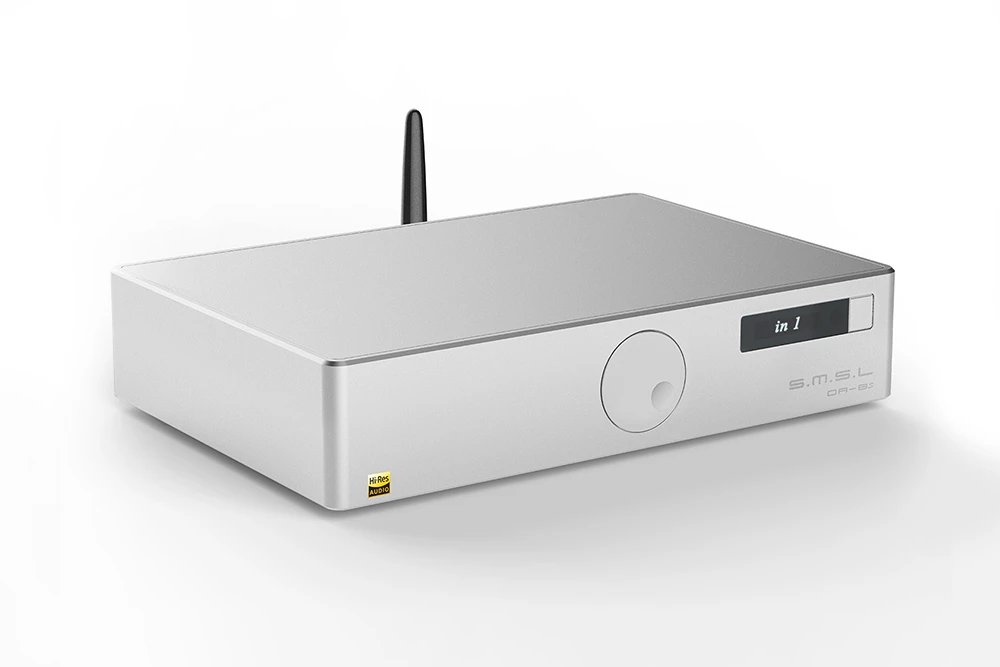
The DA-8s is one of the latest, solid-state, Bluetooth enabled, desktop-style 2-channel speaker amplifiers, from Shenzhen ShuangMuSanLin Electronics Company (S.M.S.L), based in Shenzhen, China. S.M.S.L has been making amps since 2009 and primarily focuses on the compact, and medium-size players, amps and DACs. The DA-8s comes from a long legacy of amps from S.M.S.L including the D Series, SA series, A series and Q series of amplifiers. Most notable is the DA-8s’ higher performance brother the DA-8, which lacks the Bluetooth but makes up for it with higher SNR and lower THD+N. S.M.S.L is part of the wave of smartly designed, affordable, featured filled, and sleek looking amplifiers coming out of the Pearl River Delta. Let’s see how it stacks up.
The DA-8s is a very practical and straightforward amplification solution with big ambitions towards driving small home shelf speakers or a PC setup that’s also used as an entertainment center for movies etc. While the size is a little bigger, or longer specifically, than some other desktop amps out there like the Fosi BT20A or Sabaj A4, it makes up for it with a more sleek look that fits in better with home electronics (yes, looks do matter). Having XLR, RCA and BT inputs on a desktop-style amp say right away S.M.S.L’s ambition for this device is to drive the newer generation of bigger shelf, desktop, and auxiliary PC speakers very well (more on the results below). The addition of the BT5.0 receiver so you can stream through the device plus an added remote control and price of around $170 makes it an attractive value for an attractive device.
The DA-8s uses the Germany-based Infineon’s Class D amplifier chipset which really is useful for lower power consumption and its smaller size is perfect for compact devices. The DA-8s deploys Infineon’s MERUS IC amp and chip module technology, which was designed specifically for portable and compact HiFi audio solutions. Class D is known for its efficiency but has been bemoaned for sound quality issues, but the new technology has evolved as the new chipset is what I think is the difference-maker in this device. The Infineon chip is also packed with PQFN thermal efficient materials which reduces the need for heatsinks. All of this is great for small desktop style devices – keeping it small, but efficient and cool. The balanced input-to-speaker design of the DA-8s, combined with a patented sound and treble/bass adjustment feature created by S.M.S.L engineers, gives the user the control to match any speaker or music genre to their taste through the settings.
The engineers at S.M.S.L also added an NJW1194 electronic control chip from Japan’s Nagano Japan Radio Co., Ltd. The chip, which generally has more industrial uses, in the DA-8s provides for a much higher grade of volume control that also reduces distortion. The chip adds a smooth feel to the volume control either on the device or in the remote that seems to provide an amazing range of volume which makes it easy to find the sweet spot for your particular mood or setting.
While it’s not the first desktop amp to use Bluetooth (BT) as an input, I find it very relevant for the intended use cases of the DA-8s, which includes a BT 5.0 chipset, including Qualcomm aptX. BT 5.0 codec touts lossless audio and imperceptible aural lag (perfect for gaming). It also extends range, reception, and streaming sound quality. This adds a number of great uses for the device – including high-res streaming. Combine that with the balanced design of the device, and you can stream high-res tracks with great end-to-end reproduction from the speakers. But the key to why this is so important is that you can use your phone or BT enabled DAP to easily pair up and stream in high-res. So you get a really good amp for your desktop setup that allows the freedom to easily pair and use a BT device which then lets you control your music experience. This makes it more attractive especially to the younger audiophiles that expect BT.
As I mentioned in the intro the DA-8s was designed with XLR, RCA and BT inputs, giving a wide variety of input options and makes adapting a DAC into the kit very easy and this is needed as the DA-8s’ DAC is Bluetooth only. There is also a 5-way binding post on the back for connection to your two-channel speakers along with an AC port that uses a specially crafted adapter for better regulation of power to the device. You will find no digital inputs though other than the BT so there must be a DAC inside for the Bluetooth feature, but it’s most likely a component of the BT chip with no external input. Polish this off with all gold-plated inputs and outputs, onboard heat protection for the board and also a low power standby, up to spec for EU, and you have an effective, quality device that punches above its weight.
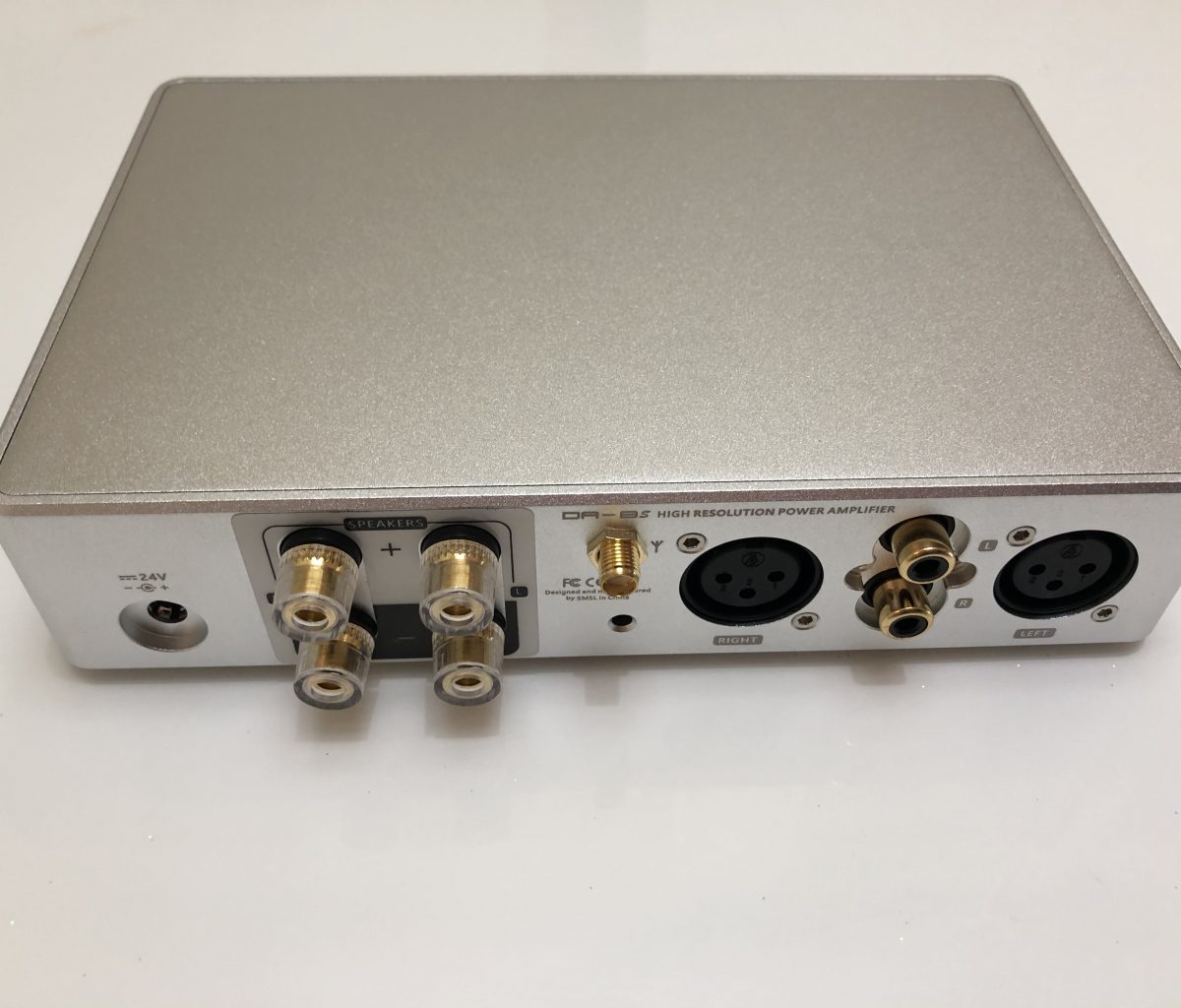
Building on a solid device design, the DA-8s also offers a bunch of features, although here there was some room for improvement. Yes, it has an OLED display on the front, but it’s very tiny and narrow, and hard to see in some lighting situations. Adding a little size here would have been nice as I was squinting at times going through the menu. However, they did include a remote, which almost makes up for this, as once you learn the simple controls you can work every setting from the remote. The remote was also nice and not a lot of amps at this price include a remote, which makes having the amp a little less laborious, especially if you like lots of different types of music or use it for your speakers while gaming.
One place where the DA-8s is a winner is that they managed to pack all that cool tech into an all-aluminum alloy CNC precision processing shell with anodized surfaces. It reminded me a lot of the look of the original Sony Discman and was similar in size. The front has a single scroll wheel where you interact with the UI. The shape, while longer, paid dividends in that it was so thin it was easy to slide under a monitor or PC stand, which is perfect for desktops.
The menu includes 7 pages, input selection menu, BT setup, EQ menu (I’ll talk about this more in a sec), treble adjust, bass adjust, main UI, and dimmer function (it can get very bright). You will notice there is no main menu EQ feature, which I miss. However, and probably owing to the control chip, and S.M.S.L’s onboard proprietary sound DSP, you can feather the treble and bass to get it just where you like it. It kind of reminded me of the two treble & bass knobs that were on my Pioneer deck in my 1993 Civic. There are also a few presets, one is S.M.S.L’s default, based on the same sound technology.
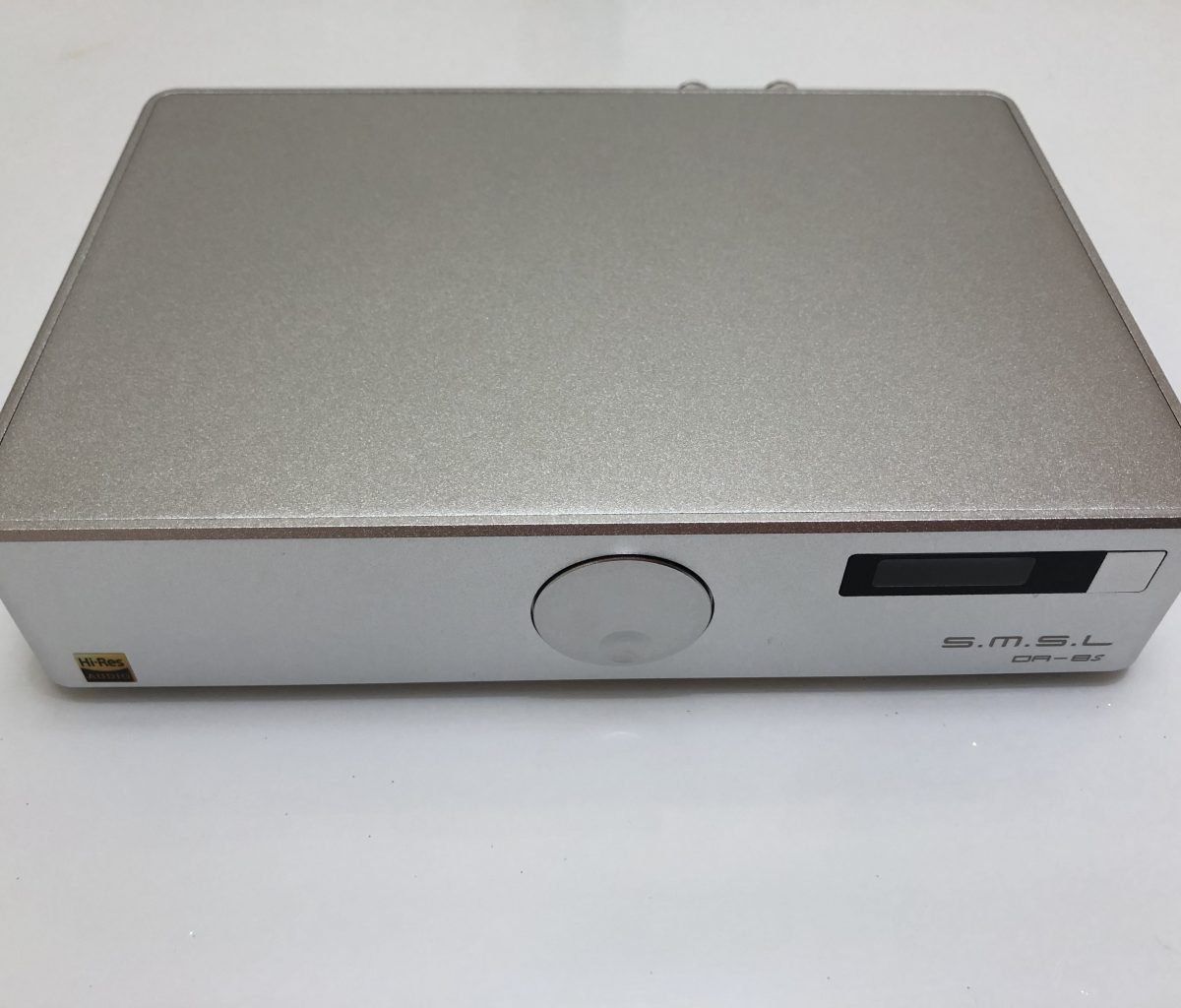
It also includes a feature that when you slide the control wheel in any direction in the BT menu it forgets the paired device instantly, then slide it again to re-pair to a new device – meaning you can easily switch between BT devices, without the labor of opening a menu, deleting an old device and re-pairing. This makes the DA-8s BT setup experience much smoother. However – the downside is that if you accidentally slide the wheel in the wrong menu – you may un-pair your device and have to re-pair the source – they made it so easy it’s almost borderline too easy. I was excited to get it plugged in.
I had to borrow some gear to be able to put this puppy through its paces. So off I went and collected some gear in addition to what I had at home. To test the DA-8s I got my hands on a Topping D90 DAC to test the XLR ports, then a Xantech XT-DAC-12 to test the RCA input, one of my favorite DAPs is my Fiio M11 Pro with THX AAA™ amplification which I used to test the BT input and a set of wood-finished Jamo S803 speakers for my left and right and a Fosie BT20A amp and Sabaj A4 amp for comparison.
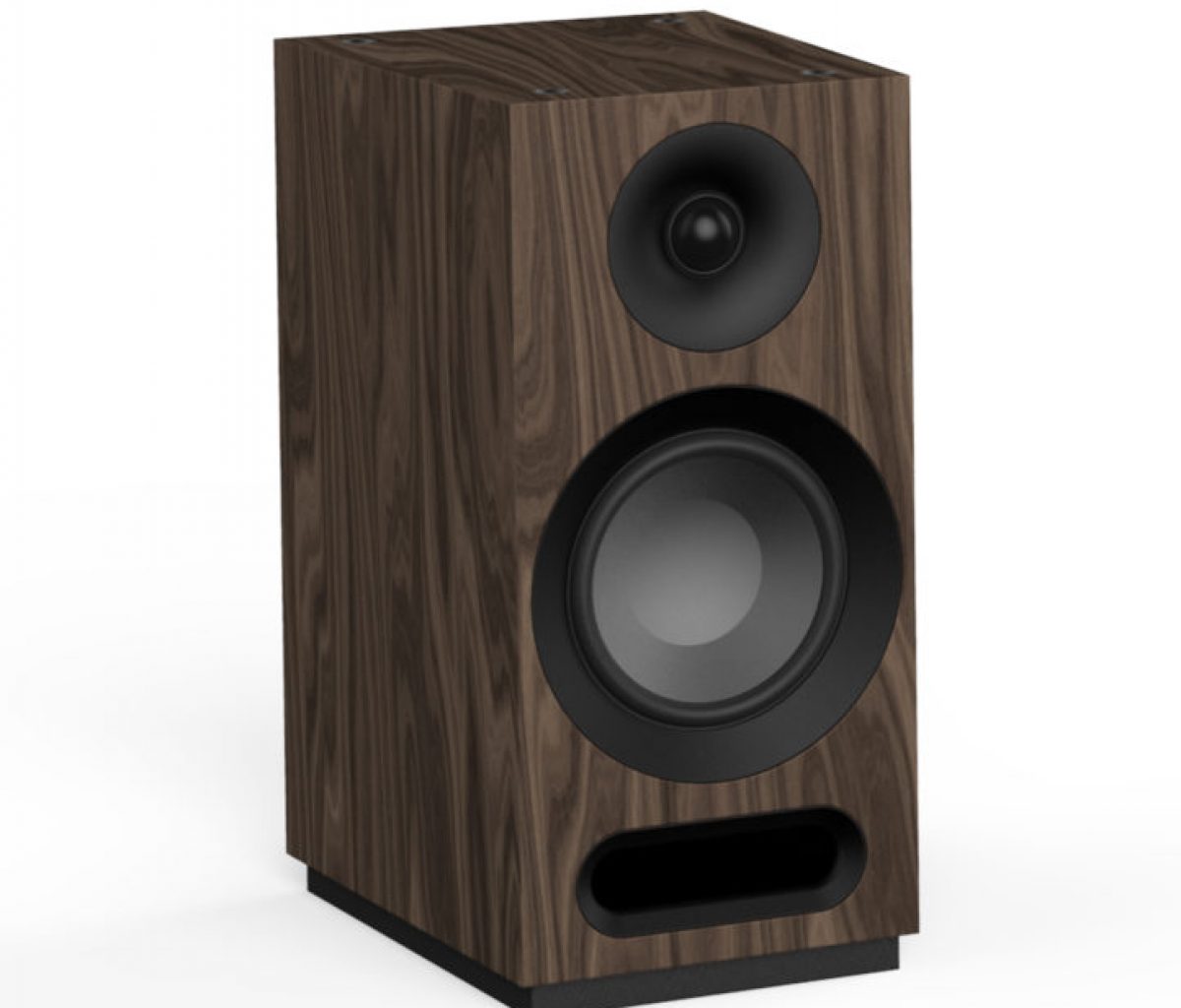
The Jamo S803s I was lent are Walnut Wood grain finished and offer a power handling up to 160W @ 8 Ohm, separate Soft Dome Tweeter and a 127mm Polyfiber Woofer and are a relatively nimble 12 pounds. The Jamos are best used right on the shelf or on a large desk. The S803s offer a very resilient sound overall and have a very, very warm sound to them. This was very good to help offset some of the v-shaped sound coming from the DA-8s.
Using my computer as the source, I connected the Topping D90 to the XLR ports on the DA-8s using a QED Reference XLR interconnect, which was in turn connected to the Jamos via Audioquest Type 4 speaker cables. I am a huge hip hop fan – so I went right into Tupac’s “To Live and Die In LA” – and probably just got kicked out of my building. The sound reproduction was exceptional with exceptional tonality, and an extended feeling of warmth and presence and of course bass. The relatively V-shaped sound was OK for my tastes and could be offset by using the sound setting or speakers that add more range in the middle. The noise floor was excellent, with no pops or hisses or crackles even with the DAC signal being fed in, it was the same while playing tracks too, nice and clean in the empty spaces.
I went on to a live recording and had to reconfigure the DAC to a lower DB setting to avoid alarming my neighbors once again. The Doors’ live version of “Alabama Song”, came through with great presence, I noticed some background sounds peaking out, mumbles of the crowd, the pick on the guitar strings, and that feeling of being in the room and then you notice you have been tapping your feet to the beat for like 3 minutes before realizing it. The 3D-like presence of the sound being projected in front and behind me was exceptional. This is the tell-tale sign of high-end sound reproduction from an excellent recording. This was where the S.M.S.L really shined, and was the best setup in terms of sound quality of all the inputs, by a wide margin. This is a situation that comes down to just having the right components in the right configuration – that makes a huge difference.
Using my computer as the source again, I then used the XT-DAC-12, using the RCA inputs with stock cables. This is where the DA-8s did not shine – there was a major drop off in quality that was immediately noticeable. The cymbals at times hissed, and bass thudded a little more at higher volumes – I shouldn’t have listened with the XLR setup first. I replayed the same two songs, all the way through and it just sounded bland and dim in comparison to the XLR which also sound really balanced on the left and right, whereas the RCA did not reproduce the left and right as faithfully. The tone and range were just not the same and dropped off at higher volumes at the top and bottom.
I had the expectation that the BT quality would be a drop off, but here I was also really surprised. I paired my M11 Pro and using the same settings on the Topping DAC. I replayed the same two songs and was VERY surprised to hear the difference. The BT provided that same sense of space and being in the room of the recording versus being in your room. I jumped back and had to A /B between the XLR, and RCA inputs and the BT several times to see that the XLR inputs still resulted in the best overall sound reproduction, but the BT was a hairsbreadth away from the quality produced when using the XLR setup and computer as source, and I have some ideas why down below.
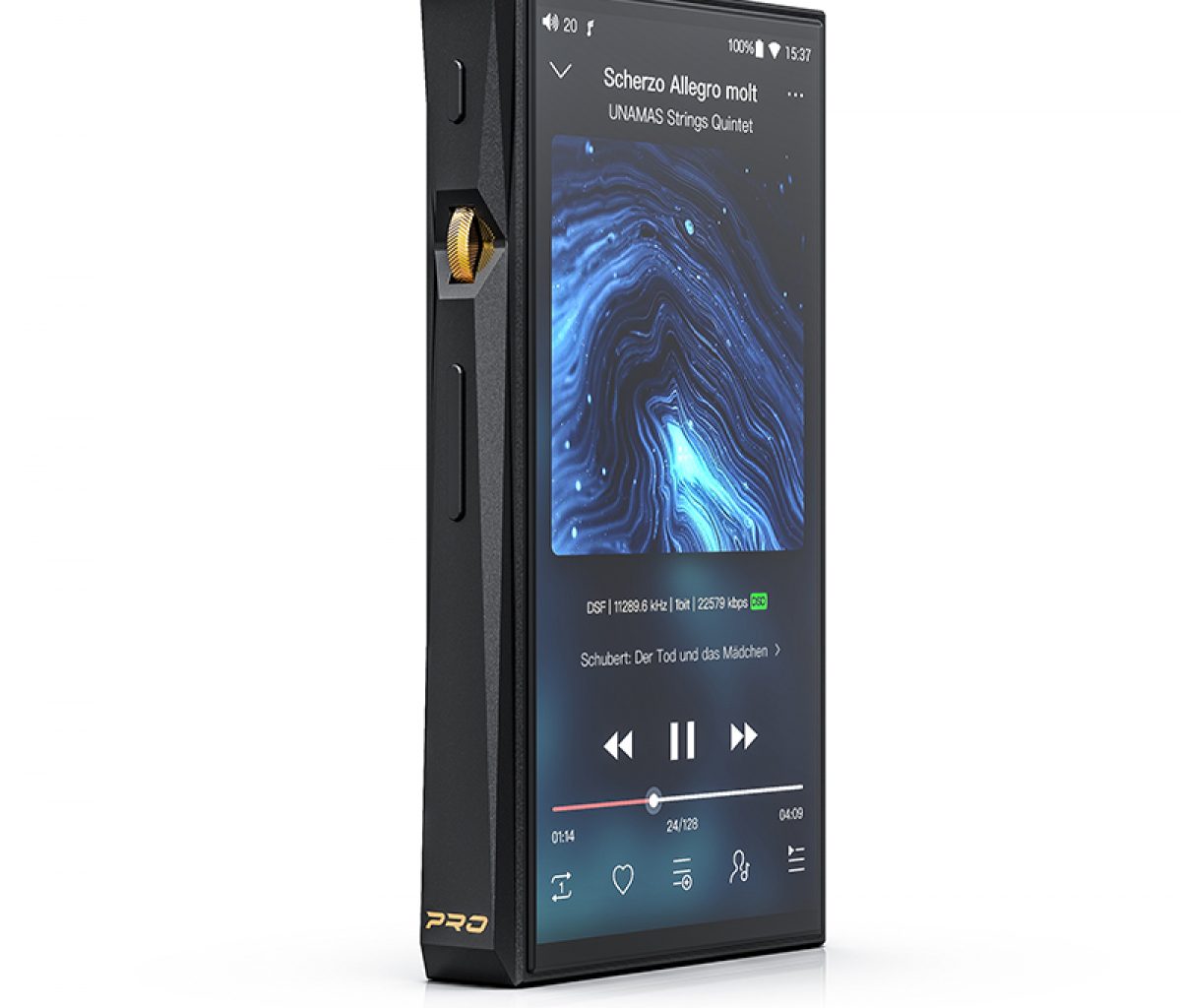
Overall, the DA-8s performed very nicely and above where I would have thought – way above. I believe this is due to the new Infineon Class D chips, which seem to punch above their weight. While the manual says you can get 80W per channel, usually at 50W or so you start to hear distortion in this range of devices. But it felt like the power per channel was closer to around 60W+, without distortion and if I cranked the DB on the Topping higher and increased the volume, it could have filled a large room and powered a small two-channel home movie system with ease, in my opinion. This was true for the BT input too, possibly due to having an additional onboard DAC for decoding the BT signal + the S.M.S.L proprietary DSP. I have two amps I got last year and I tested them to compare as they were in the same price range and also Class D amps with BT in the $100-$200 amp product range of solid-state amps the DA-8s goes right to the top of the pack.
My Fosie BT20A offers very similar sound reproduction (and now costs about $80 less) as the DA-8s when in XLR input mode, and packs a much higher wattage per channel (100W @ 4 ohms). However, the BT20A lacked anything except RCA input and outputs, and a more technical, dumbed-down manual UI and only BT 4.2. So maybe you get a bit more wattage and similar sound but the spec of the DA-8s is way better and so are the design and features.
I have a Sabaj A4 that I use with my Sony 7.1 channel BDV-E385 home theatre system which I use in my living room and it delivers great sound as well and it also has a direct subwoofer output and also a digital optical input, which is nice to have as that is more standard these days for home audio. It also costs a little less ($129) than the DA-8s, which is nice, but you give up your XLR ports and BT 4.2 instead of BT 5.0 and remote. The Sabaj does look a lot nicer than the Fosie and is more in line with the look of the DA-8s as it does have more of a sleek look, but still has a simple manual UI.
Conclusions:
Overall I was very surprised by the little amp, it’s looks, features and design are above average – I would happily exchange either of the ones I have for this one without hesitation. As a simple Bluetooth amp solution, when combined with the Jamo S803’s and Topping D90, it created audio magic right in my living room. The S.M.S.L DA-8s really brought out all the Jamo’s had to offer – if I had gone full-throttle on both the AMP and Topping DAC I could have melted the Jamos for sure. Honestly, besides the RCA input being off-color (although possible due in part to the difference in DAC input), the rest of the DA-8s is pretty flawless for its price and does punch way above its weight. As I said above – having the right components that work well together in concert often result in surprising results. For me the Topping D90 + QED Reference XLR Interconnects + S.M.S.L. DA-8s + Jamo S803 speakers = magic. The DA-8s is a straight-forward amplification solution, and it kicks butt in its category, and I highly recommend it, it certainly has replaced my current favorite Sabaj A4 until I have to give this back. If you don’t mind not having BT and are looking for a single-ended solution try the more performance-oriented brother, the DA-8.
I found the DA-8s to be reliably in stock on Shenzhen Audio’s website.
Specifications
S.M.S.L DA-8s:
Price: $169.99
Inputs: XLR, RCA, BT 5.0
THD+N: 0.008%
SNR: 90dB
Channel separation :88dB
Output Power: 80Wx2(4Ω) / 40Wx2(8Ω)
Power Consumption: 35W(Normal Volume)
Standby power: <0.5W
Size: 185x40x125mm (W x H x D)
Weight (In shipping carton): 1.2kg














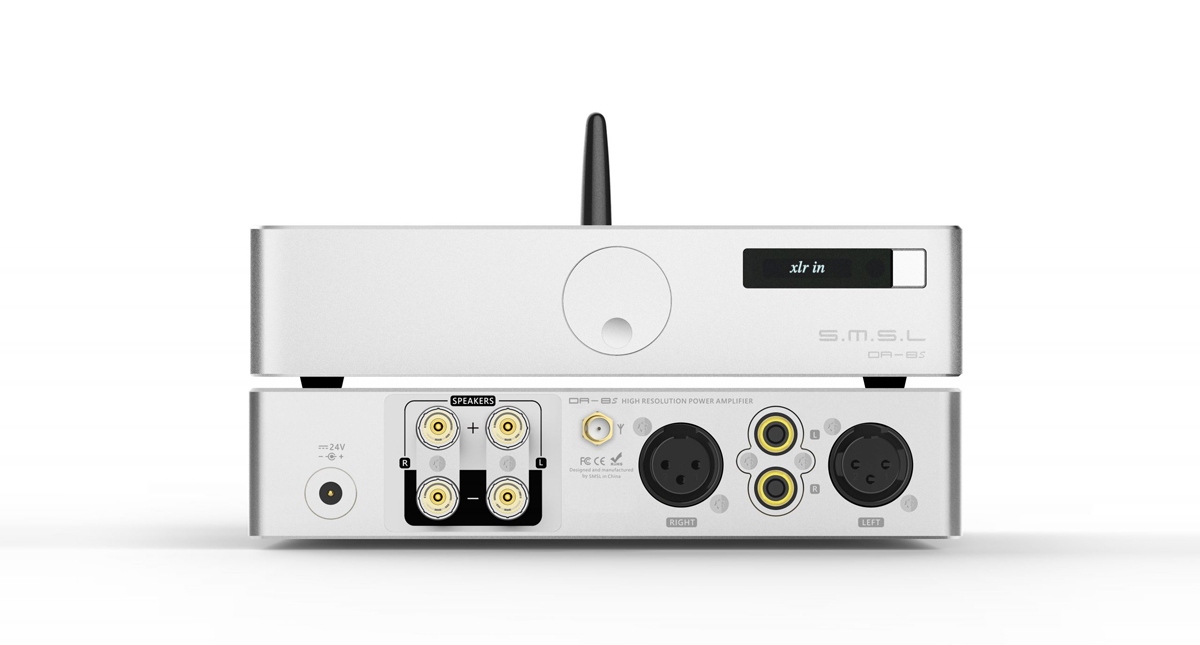
Reply
Reply
Reply
Want to join discussion?
Feel free to contribute!